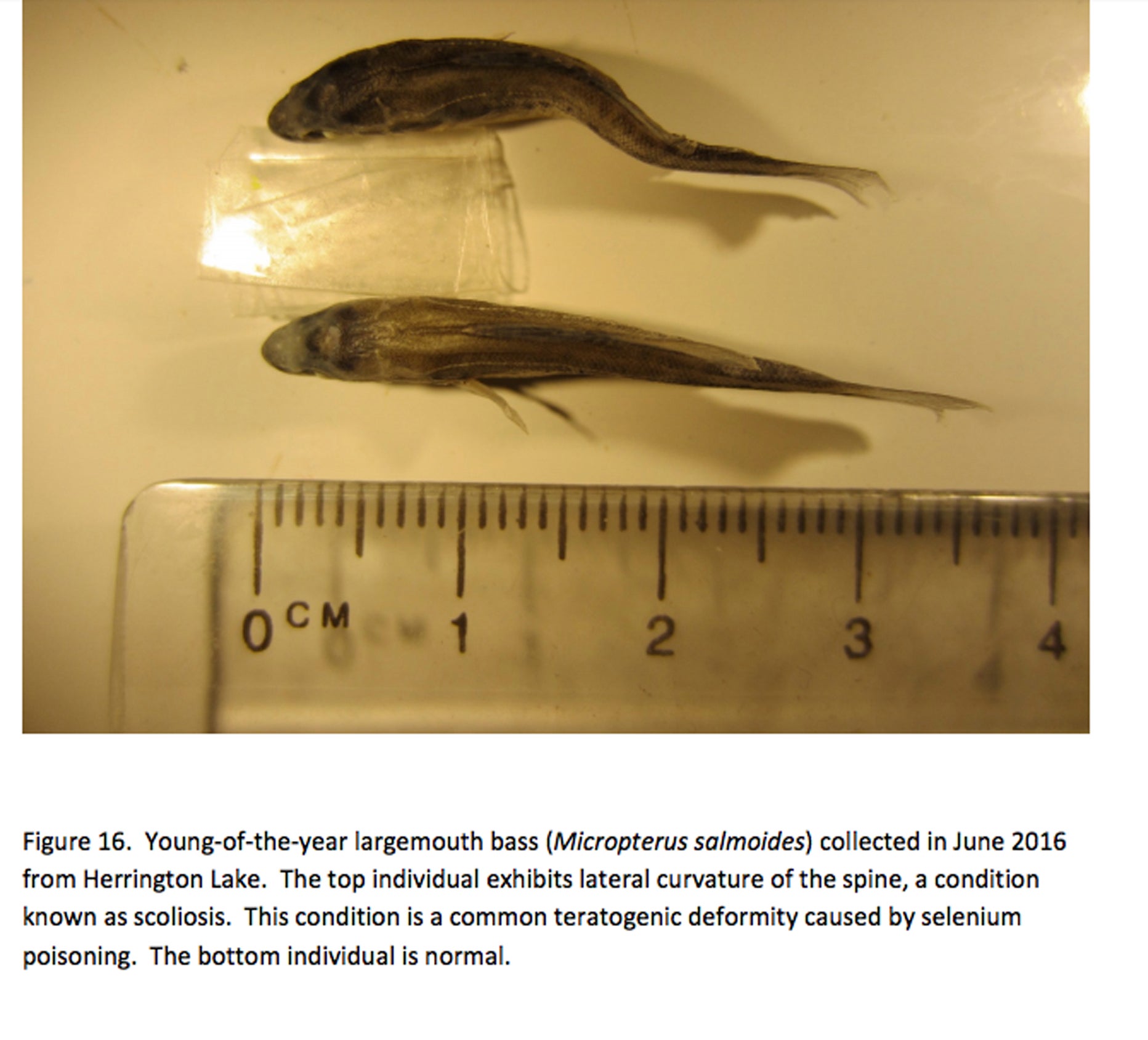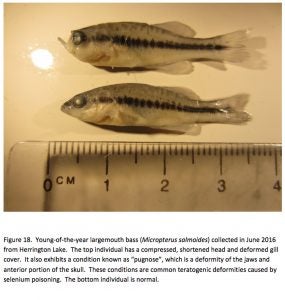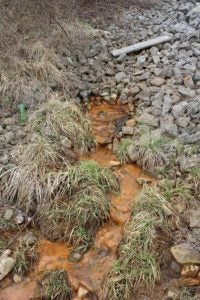Smoking gun or red herring? Herrington Lake residents want answers
Published 7:00 am Monday, November 20, 2017

- A photo and explanation of evidence, submitted by Dr. Dennis Lemly on behalf of the plaintiffs suing Kentucky Utilities over pollution in Herrington Lake.
Editor’s note: This is the second part of a two-part investigative series looking into a battle over what to do about a toxic waste site at E.W. Brown Generating Station in Mercer County.
Residents around Herrington Lake say they feel their concerns about a coal ash pond that may be polluting water in the area are going unheard.
“I don’t feel like the public has much, if any, input into what happens,” says Julie Pease.
The coal ash pond in question was used by Kentucky Utilities to dispose of waste from burning coal at the E.W. Brown Generating Station until 2008, when it was closed. The 6 million cubic yards of coal ash have been capped and covered with a landfill, but a lawsuit filed earlier this year alleges a corrective action plan proposed by Kentucky Utilities is “deficient and restricted, such that the public has neither been adequately informed about the CAP nor afforded full and fair opportunities to voice their concerns.”
The same suit uses data collected by Dr. Dennis Lemly to point a finger at the coal ash pond for high levels of selenium in the lake that are causing deformities in fish.
Pease has been very vocal about the situation. A Herrington Lake resident, she’s written letters to the editor in order to keep the general public apprised on how to submit comments and who to try and get through to.
“The plan doesn’t do anything. They have this unlined coal ash pit. Even if they’ve capped it and did a landfill, what is still in there is still seeping out.”
Pease says her feeling is “that it’s a done deal. If they really wanted to know what we thought, they’d have a public hearing. It’s kind of how I sense government is in general at this point in time — they don’t really care what the individual people think. I continue to try and register comments, but I don’t feel like I’m being heard. I continue to do it, because if I’m not putting it out there, then I can’t say I’m not being heard. However, I feel like it’s not making any difference.”
Brett Werner is another resident who lives on the lake. He’s an environmental studies professor at Centre College, and says he’s been working with students on the case.
“This is hard to explain to my students because it’s not altogether clear. There’s two parallel things going on — one is a lawsuit and one is the Kentucky state regulatory process. There’s a relationship between the two.”
Werner said he’s having his students follow the case.
“This semester, I’m teaching environmental policy and have brought this case into the classroom because it’s real. And I live on the lake, I swim in the lake, and I’d love to fish in the lake — but I don’t.”
Werner says he’s not a part of the Sierra Club or Waterways Alliance, but he supports what they are doing.
“I grew up in South Dakota, and I regularly fished and ate the fish we caught. I don’t do that here because I’m worried about the toxicity limits of the fish here,” he says.
Werner says he does feel a pubic meeting or hearing of some sort is warranted, and his questions are about the ambient water quality and where the water quality problems are coming from.
“It seems to me like our goals, our targets for having clean water in the country are to have our water be drinkable, swimable and fishable. I’m not sure we’re meeting all of those goals or targets here.”
He says he was one of the people who sent in a first comment asking for a public hearing “and to make the testing documents publicly available, and to give us more time for the public comments. I understand the constraints on state government, but I think are all reasonable requests.”
Werner also says when he went to the website looking for the documents to understand what KU’s plan was for figuring out the issue, the link supplied by the Kentucky Energy and Environment Cabinet didn’t provide those documents.
He says the cabinet did respond to him promptly and supplied a password, and he considers himself an open-minded person who wants to be positive about all of this and give the benefit of the doubt.
“But that’s not open or public, to have to use a password. That’s a pretty telling, significant and chilling factor, if you ask me.”
Werner says after reviewing the documents, he would not call what KU has submitted a corrective action plan.
“I was less than impressed. I wrote (the state) and said … they were pointing to the things they didn’t know and said they’d figure out the answer to these things. Which seems like a good idea — if we don’t know the sources of the heavy metals, seems worthwhile to figure it out. But that’s not a corrective action plan. They could have done that years ago, when this was first brought out — five or six years ago. All it seems to me to be is a scientific study plan.”
The fact that KU will be performing its own tests through contractors it’s responsible for hiring also seems questionable, he said.
“I could see when things are going well, and there’s no complaint, I can see normal operating procedures, I could see having a private contractor, that seems like normal, and the state probably should be auditing and checking. But as soon as there’s this complaint — seems like the state should be doing it, or a third party should be doing it …”
Pamla Woods is another resident in the area above the Brooklyn Bridge. She is on the board of the Kentucky Waterways Alliance, and has been off and on for the last 20 or so years. She is also retired from the Division of Water and has worked in watershed management, making sure everyone understood whatever they do impacts their water ways.
Woods says the state hasn’t “made KU take as effective action as we wanted,” but “collusion” — is a strong word.
(Thomas Cmar, an attorney with Earthjustice, which filed the lawsuit, told The Advocate-Messenger “our concern is that the state is working in close collusion with KU, and that KU does not want members of the public to know what’s going on in their own backyards, or to know just how bad the problem is, that this pollution is going into the lake and harming the fish.”)
Woods says she has “followed the particulars” of the case, but she knows “the state is limited by the regulations and the laws. They also have massive budget cuts — I don’t even know who they have to do the enforcement.”
Woods says in her experience, generally, state government tried to be reasonable and give the utilities and whoever the benefit of the doubt.
“Sounds like they’ve aired on the side of being a little too reasonable concerning the chemicals we’re talking about.”
Woods says selenium is not the only concern; there’s also arsenic, lead …
“The site of the area is huge. If you look at it on Google Earth, I was astonished …” she says. “I’d like to know … what are you going to do to stop it? And that’s no easy feat, and I understand that. It’s a huge pond, leaking — it’s really hard to deal with. Hard to identify where it’s leaking and how you can stop it.”
Woods said her questions on the issue include “What are your engineers looking at, and what alternatives have they considered? What might you have to do? Is it a berm? Do you need to line it? What are the options? So, why did you think it wasn’t going to leak? And what should be done to keep it from leaking?”
The scientist
Dr. Lemly, a private consultant, was hired by the groups suing KU to perform tests in the area. A fishery research biologist for 30 years, Lemly was with the federal government for six years in Fish and Wildlife and 24 years with the U.S. Forest Service. He recently retired in 2016.
“My work is involved in coal and coal ash pollution for my entire career,” Lemly says. He’s investigated thousands of coal ash sites as part of his focus on selenium, and says there’s never been an instance where contamination at the levels found in Herrington Lake wasn’t specifically caused by the selenium in coal ash leaching into the waterways. If that was the case, he says this would be an unprecedented case — different from anything he’s published over the last 24 years.

“It is a direct cause with the pond … They’re saying hypothetical, it’s a naturally occurring element. But this is a highly concentrated source of selenium that happens when coal is burned.”
Lemly says this problem will only worsen over time. It will continue to increase in sediments and in the aquatic food chain.
“Birds are highly sensitive to selenium poisoning; so are fish. My estimation is at some locations, where sediment samples were high, it will take 43 years for the system to clean itself up to be non-toxic, even if all selenium inputs into the lake were cleaned out today.”
Lemly looked at over 500 young fish and says more than 12 percent of them were deformed because of the poisoning. By comparison, looking at a lake where there’s no source of pollution, deformities will be less than half of 1 percent.
“It’s over 25 times more than what it should be. Combine that with high levels in fish tissues — it’s a case-effect linkage. It’s a smoking gun. We know it’s poisoning the fish in Herrington Lake, and they recognize and understand this.”
The ultimate tragic outcome, Lemly says, would be collapse of the fish population.

Photo courtesy of the Kentucky Waterways Alliance
Kentucky Division of Waste Management (DWM) had employees on a site visit on Feb. 20, 2014. On the site visit, they recorded a video of a discharge occurring and noted a number of other hydrogeologically significant features and contaminated areas.
“The poisoning doesn’t kill the adults. You won’t see a bunch of dead fish floating on the surface, but over time, the fish just disappear.”
Lemly says he’s seen cases where the fish are simply wiped out. The sports fish disappear because of selenium poisoning preventing reproduction — it’s an insidious mode of toxicity and reproduction, he says.
“It’s a very big picture that you have to see. It’s a complex picture. The case is very easy to see, for anyone who wants to look closely at it. It’s been repeated time after time after time — there’s nothing unique about Herrington Lake or the E.W. Power Plant. They’re all over the Southeast, and the evidence is clear and inescapable and the contents are very grave for fish and wildlife. The solution is to stop it. Even so, it’ll be a long time for the lake to clean itself.”
The company
KU’s VP of Communications Chris Whelan was asked about the company’s action plan, which details a testing period extending at least through 2019, and asked if the company can understand the sense of urgency residents and lake-lovers have to get the site cleaned up. She said the power plant is monitored in accordance with the state’s landfill and water discharge permits.
“As part of our agreed order with the state, we are also in the midst of a comprehensive aquatic study, which we expect to complete in late 2018 or early 2019, depending on the sampling and follow-up that is required,” Whelan said.
She says that timeframe is necessary to ensure the company completes a thorough study to determine any risks to the lake.
“We do not think it would serve anybody’s interests to take any shortcuts.”
However, Whelan went on to say KU feels the Sierra Club, who is a plaintiff on the suit, has provided “no underlying data to support the conclusions contained in their study, and we have a number of serious questions and concerns about the quality and reliability of that study.”
Whelan was asked if the company is asserting Dr. Lemly’s findings are unreliable.
“As for the study, we have not seen the data behind Dr. Lemly’s study, so we have no way to determine the validity of it. However, based on what we have seen in the summary of his findings, we have significant concerns about the methods he employed and the conclusions he has drawn. Furthermore, we know his opinions were secured by a party to the litigation and that this is typical legal posturing in an attempt to change their position in the eye of the court.”
Whelan says simply put: The conclusions in the Sierra Club report are inconsistent with current conditions observed in the lake.
“The Kentucky Department of Fish and Wildlife Resources has rated fishing conditions from fair to excellent, depending on fish species. For large-mouth bass which is the focus of the Sierra Club report, the department has rated fishing as ‘good’ since 1995.”
Whelan says there is an agreed order with the Energy and Environment Cabinet and it has approved the initial sampling plan and sampling protocols “because it was important to complete our initial sampling before the seasonal change in lake conditions in October. We are still awaiting approval of the overall corrective action plan.”
Whelan says the company has implemented a previously approved remedial action plan and corrective action plan, which involves closure of the old ash pond, construction of an environmentally protective landfill, and “other measures which should mitigate any migration of coal ash constituents.”
Last week, KU announced it would be retiring units 1 and 2, the two oldest coal-fired units at E.W. Brown. Whelan says once they are completely shut down, they will proceed with the closure of the auxiliary pond in which coal combustion residuals are stored.
“While we believe we have already taken all appropriate environmental management measures, our study will provide the cabinet with information to determine whether any additional measures are warranted.”
Whelan was asked about the claim that the company was taking a wait-and-see approach to cleaning up the discharge site, regardless of information the company itself provided on the high levels of selenium in fish of the area.
“We continue to be confident that we are in compliance with our landfill permit and the discharge limits in our water discharge permit, which were set by the Kentucky Division of Water in 2010 to protect human health and the environment,” Whelan said.
She says the company has spent $100 million in recent years to close its old ash pond, construct an environmentally protective landfill, and implement other measures “which have substantially enhanced environmental protections at the Brown plant.”
“This is absolutely not a ‘wait-and-see’ strategy,” she said. “More importantly, monitoring conducted by the cabinet indicates that water quality in Herrington Lake remains safe for recreational use and complies with primary drinking-water standards aimed at protecting human health.”
Whelan says that based on the Kentucky Department of Fish and Wildlife Resources’ 2016 Annual Performance Report and 2017 fishing forecast, fishing conditions are rated from fair to excellent, depending on the fish type, in Herrington Lake.
“And, according to KDFWR’s Herrington Lake Bass Assessment for 2016, ‘The largemouth bass fishery at Herrington Lake has averaged a good rating since 1995…Biologists expect the future of the largemouth bass fishery at Herrington Lake to continue being strong.”
Calls to the information officer with the Department of Fish and Wildlife went unanswered for this story.






